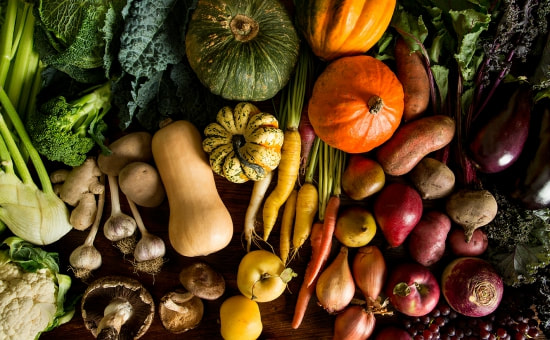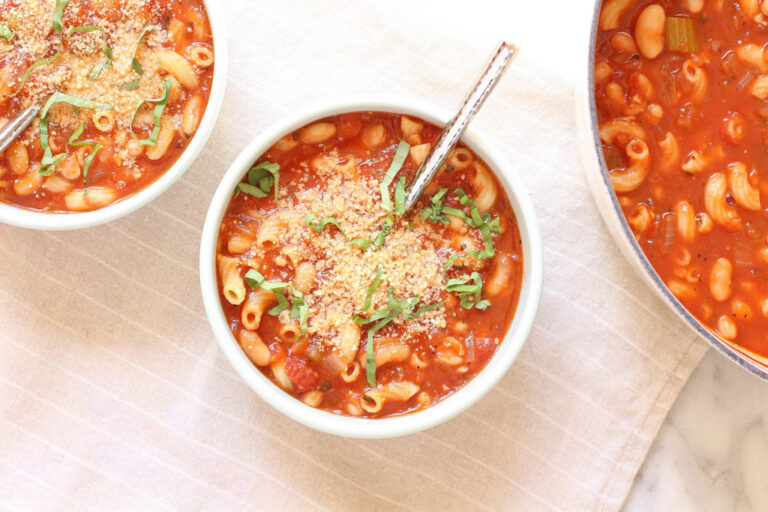A bowl of vegetarian pasta salad is not just a dish; it’s a canvas where flavors and nutrients come together in harmony. This guide is crafted to help you pick the freshest ingredients that not only tantalize your taste buds but also contribute to your well-being. Whether you’re a seasoned chef or a kitchen novice, understanding the components of this wholesome meal is key to creating a salad that stands out.
The secret to a mouthwatering vegetarian pasta salad lies in the blend of textures and tastes. From the al dente pasta spirals that form the foundation to the crisp, colorful vegetables that add a crunch, every element plays a pivotal role.
We’ll walk you through selecting the perfect pasta, combining it with a rainbow of vegetables, and tying it all together with a dressing that packs a punch.
So, let’s embark on this culinary journey about vegetarian pasta salad ingredients to elevate your next meal with a salad that’s as nourishing as it is delightful.

Choosing Your Pasta Base
The foundation of any great vegetarian pasta salad is, undoubtedly, the pasta itself. The right choice can transform your salad from a mere side dish to the star of the dining table. Here’s how to select and prepare the perfect pasta base for your salad.

Types of Pasta Best Suited for Salads:
When it comes to pasta salads, not all pasta is created equal. Short, sturdy shapes like fusilli, rotini, and farfalle are ideal. They not only hold up well when mixed with other ingredients but also have nooks and crannies that catch and hold onto the dressing, ensuring every bite is as flavorful as the last.
Whole Wheat and Gluten-Free Options:
For those looking for a healthier alternative or catering to dietary restrictions, whole wheat pasta provides a nutritious twist, while gluten-free options made from rice or quinoa flour ensure everyone can enjoy the dish without concern.
Cooking Pasta for the Perfect Texture:
The key to pasta salad perfection is cooking your pasta ‘al dente’ – firm to the bite. This means following package instructions but usually subtracting a minute or two from the cooking time. Once cooked, drain the pasta and rinse it under cold water to stop the cooking process immediately. This also helps to keep the pasta from sticking together.
Prepping Pasta for Salad:
After rinsing, toss the pasta lightly with olive oil. This not only adds a layer of flavor but also prevents the pasta from becoming one big clump. Allow the pasta to cool down to room temperature before adding it to your salad. This ensures that the heat doesn’t wilt your fresh veggies or herbs.
By carefully selecting and preparing your pasta, you set the stage for a salad that’s both satisfying and delightful to eat. Remember, the pasta is more than just a filler; it’s a crucial component that, when chosen well, elevates your vegetarian pasta salad to new heights.
Fresh Vegetables: The Heart of Your Salad
Vegetables are the vibrant core of your vegetarian pasta salad, providing not just a burst of color but also essential nutrients and a variety of textures. Here’s how to select and prepare the vegetables that will make your salad truly shine.

Selecting the Right Vegetables:
When it comes to choosing vegetables, think about a rainbow of colors to ensure a wide range of vitamins and minerals. Classic choices like red bell peppers, cherry tomatoes, and cucumbers offer a crisp texture and refreshing taste. Carrots add a sweet crunch, while purple cabbage brings a pop of color and a dose of healthy antioxidants.

Preparing Your Vegetables:
Wash all vegetables thoroughly under running water to remove any dirt or pesticides. For vegetables like cucumbers and carrots, peeling is optional but can be done for a smoother texture. Cut your vegetables into bite-sized pieces that are easy to fork and pleasant to eat. Consistency in size not only looks appealing but ensures an even distribution of flavors.

Seasonal Variations:

Embrace the seasons by incorporating vegetables that are at their peak. In the summer, add sweet corn or zucchini for a sunny flavor. During the fall, roasted butternut squash or pumpkin can introduce a comforting warmth to your salad. Winter calls for heartier options like roasted Brussels sprouts or kale, while spring welcomes asparagus and snap peas.
Mixing It Up:
Don’t be afraid to mix raw with cooked. Some vegetables, like broccoli or green beans, benefit from a quick blanching, which enhances their color and makes them tender-crisp. Others, like roasted red peppers or sundried tomatoes, can add a depth of flavor that raw vegetables alone cannot achieve.

By thoughtfully selecting and preparing your vegetables, you create a salad that’s not just a treat for the taste buds but also a feast for the eyes. Remember, the more colourful your salad, the more appealing it will be, so don’t shy away from adding a variety of hues and textures.
Protein Sources for a Satisfying Meal
Incorporating protein into your vegetarian pasta salad is crucial for transforming it from a simple side dish to a fulfilling main course. Here’s how to infuse your salad with protein-rich ingredients that are both nutritious and delicious.

Beans and Legumes: Powerhouse Ingredients: Beans and legumes are the go-to options for plant-based protein. Chickpeas, black beans, and lentils not only add a hearty texture but also pack a protein punch. Rinse canned beans to reduce sodium, or cook them from scratch if you prefer. They blend seamlessly with the other ingredients, absorbing the flavours of your dressing and spices.
Tofu and Tempeh: Versatile Additions: Tofu and tempeh are soy-based proteins that are incredibly versatile. Marinate them in your favorite herbs and spices, then bake or grill for added texture. Dice them into bite-sized pieces to ensure they distribute evenly throughout the salad.

Cheese: A Classic Choice: For those who are not vegan, cheese can be an excellent source of protein. Feta, mozzarella, and goat cheese are fantastic choices that offer a creamy texture and tangy flavour. If you’re looking to keep it vegan, there are numerous plant-based cheese alternatives available that can mimic the taste and texture of traditional cheese.
Nuts and Seeds: A Crunchy Twist: Almonds, walnuts, and sunflower seeds are not just for toppings. They can be mixed in with the salad for an extra dose of protein and a delightful crunch. Toasting them lightly will enhance their flavor and make them an irresistible addition to your dish.


Customizing Your Protein: The beauty of a vegetarian pasta salad is its flexibility. Feel free to experiment with different protein sources to find what you love best. Whether it’s a combination of beans and nuts or a generous helping of marinated tofu, the choice is yours. The aim is to create a balanced and satisfying meal that keeps you energized throughout the day.
By thoughtfully incorporating these protein sources, you ensure that your vegetarian pasta salad is not just a treat for the palate but also a nourishing meal that supports your dietary needs.
Vegetarian pasta salad ingredients: Herbs and Spices
The right combination of herbs and spices can elevate a simple vegetarian pasta salad into a culinary masterpiece. Here’s how to choose and use these flavor enhancers to create a salad that’s bursting with taste.

Selecting Herbs for Freshness and Flavor: Fresh herbs are a game-changer in any salad. Basil adds a sweet and peppery flavour, perfect for a classic Italian touch. Mint brings a cool and refreshing zing, ideal for a summer salad. Cilantro offers a citrusy note, while parsley provides a mild, herby backdrop that complements other flavours. Chop them finely and sprinkle generously to infuse your salad with their vibrant tastes.
Spice Combinations That Complement: Spices should be used thoughtfully to enhance, not overpower, the natural flavours of your ingredients. A pinch of black pepper can add a subtle heat, while a dash of paprika gives a smoky undertone. Cumin offers earthiness, and coriander brings a hint of citrus. Mix these spices in small amounts and adjust them according to your taste preferences.
Creating a Flavorful Balance: The secret to a perfectly seasoned salad is balance. Start with a light hand, and build up the flavours gradually. Taste as you go, and remember that it’s easier to add more than to fix an overly spiced dish. The goal is to achieve a harmonious blend where no single herb or spice dominates the others.
Herbs and Spices for Health Benefits: Beyond taste, many herbs and spices boast health benefits. Turmeric has anti-inflammatory properties, oregano is rich in antioxidants, and garlic powder can boost immunity. Incorporating these into your salad not only adds depth to the flavour profile but also contributes to your overall health.
By carefully selecting and using herbs and spices, you can create a vegetarian pasta salad that’s not just delicious but also a testament to the power of natural flavours. Let these seasonings take your salad from good to great, and enjoy the delightful dance of tastes with each forkful.
Final Analysis
This is all about Vegetarian pasta salad ingredients. Crafting the perfect vegetarian pasta salad is an art that combines taste, nutrition, and creativity. Throughout this guide, we’ve explored the various elements that make up a delightful salad experience.
From selecting the ideal pasta base to mixing in a rainbow of fresh vegetables, we’ve covered the importance of incorporating protein sources and the magic of herbs and spices. Each component plays a vital role in creating a dish that’s not just a feast for the eyes but also a bounty of health benefits.
Remember, the beauty of a vegetarian pasta salad lies in its versatility. It’s a dish that invites you to experiment with flavors, textures, and ingredients. Whether you’re preparing a quick lunch or a festive dinner, the principles outlined here can help you assemble a salad that’s sure to impress.







